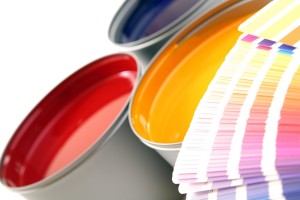
Dyes and pigments are responsible for making this world a much brighter place. Their role in varied applications is highly important and one of the industries which have been a large beneficiary of their attributes is the paint industry.
Paints are an indispensable part of our daily lives and there is no aspect which has not been touched by them. Our houses, offices, vehicles, roads, toys, equipment all have a coat of paint which gives them their bright colors and ensures a long working life. One of the major ingredients of the paint formulations is the pigment for paint. Varied colored pigments are dispersed in a suitable medium to make the paint formulation. The first step in this process is the blending of the pigment in the relevant medium and subsequent to this is the grinding of pigment particles which is done in a sand mill. This helps the pigment particles to be dispersed effectively. Thinners are then added and last step is the tinting. The paints obtain their varied hues from the pigment ingredient which also lends a wide opacity range to the paints. Paints safeguard the application from humidity and heat and some of them lend it a glistening metallic finish texture. Some pigments play a major role in creating cost-effective paint options for certain industrial applications too.
In addition to the paint industry, another major industry where colorants play a significant part is the textile industry. Colorants comprise of dyes and pigments which differ from one another in one major aspect though their basic function remains the same. The difference lies in the water solubility factor. Dyes are normally water soluble while pigments are insoluble. Dyes can be classified into different types based on their solubility and chemical attributes. Acid dyes, basic dyes, direct dyes, vat dyes, reactive dyes are just to name a few of them. Each type has a list of varied hued dyes under them. Acid red 88, Alizarine Pure Blue B are two examples that fall under acid dyes while Cibacron F, Procion MX are examples of ‘cold’ reactive dyes.
There are however, some dyes which are produced to higher standards compared to the above mentioned industrial dyesand they are the food dyes. Food dyes can comprise vat dyes, direct dyes or mordant dyes. Other dyes that are classified differently include leather dyes meant for leather, laser dyes, solvent dyes for coloring wood and creating colored lacquers, waxes; and contrast dyes used in medical imaging.
Whatever be the type of dyes and pigments the fact remains that they are responsible for making the world so bright and colorful. Whenever one sees a bright flashy color or a muted hue or any other color that appeals to one’s senses applied on any application it immediately brightens the mind of the viewer.
All manufacturers whether basic dyes manufacturers or others aim to achieve perfection in their color shades and ensure that their product is in line with international standards. This is because only top quality products can hope to sustain and thrive in this competitive market!